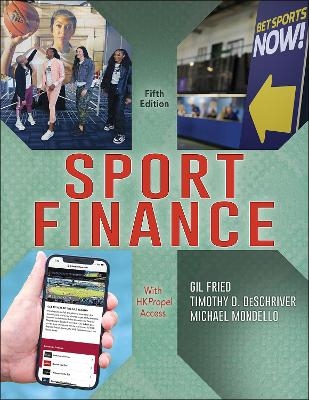
Sport Finance
Human Kinetics (Verlag)
978-1-7182-1740-9 (ISBN)
The burgeoning global sport industry is a $500 billion business with no signs of slowing down. For the upper-undergraduate and graduate sport management student exhibiting a penchant for finances and a passion for sports, the field of sport finance presents tremendous career opportunities.
No other textbook connects financial principles with real-world sport finance strategies as effectively as Sport Finance, Fifth Edition With HKPropel Access. Emphasizing a more practical approach, the fifth edition goes beyond the what and how of sport finance and dives deeper into the why—the reasoning behind the principles of sport finance—providing students with an even more comprehensive perspective on what drives the financial success or failure of any sport entity.
The text is organized into five areas, focused on the hard skills tomorrow’s sport financiers must master to perform their role: increasing revenues and decreasing expenses, developing budgets, understanding financial statements and ratios, obtaining funding and managing cash, and building a financial strategy. Each section features an insightful introduction by a renowned industry professional, providing a real-world perspective that’s sure to pique readers’ interest. Chapters addressing revenues and expenses include budgets from the sporting goods industry, intercollegiate athletics, and professional sports.
The sport industry landscape has changed significantly since the previous edition was published, and the fifth edition reflects the new realities affecting today’s sport organizations. Addressed are name, image, and likeness (NIL) rule changes; esports; cryptocurrencies; non-fungible tokens (NFTs); sport gambling; the proliferation of broadcasting rights and the sneaker market; and the impacts of COVID-19 on the sport industry.
The fifth edition’s practical takeaways are especially prominent with the addition of related online resources available to students and assignable by instructors via HKPropel. One highlight is “Two-Dollar Team,” an Excel-based simulation that introduces students to assets and liabilities, revenue and expenses, budgeting, cash management, and borrowing and reveals how these specialties work together in developing financial strategies. Three other assignable class projects involve personal budgeting, expenditures, and a stock market game. Other new features include five brand-new case studies and a profile of a typical health club, “Florida Fitness Club,” in which students are challenged to put their learning to the test by reading and understanding financial statements, setting budgets, and identifying strengths, weaknesses, and growth opportunities for the fictional facility.
Sport Finance provides students with a thorough understanding of the financial and economic aspects of the sport industry. By analyzing sport business entities and structures, financial statements, and funding sources, students will acquire the skills to make more informed and effective financial decisions, better manage the risks, and recognize opportunities in the world of sport.
Note: A code for accessing HKPropel is included with all new print books.
Gil Fried, JD, is a professor at the University of West Florida (UWF) and chair of the administration and law department, which encompasses legal studies, construction management, sport management, and public administration. He started at UWF in 2021. Prior to his appointment at UWF, Fried was a professor in the Pompea College of Business at the University of New Haven for 21 years and retired in 2021 with the designation of professor emeritus. Fried is a specialist in sport law, sport finance, and sport facility management. He received his master’s degree in sport management and his law degree from The Ohio State University. He has taught courses and written numerous books and articles on sport risk management, sport facility management, sport analytics, esports, and sport finance. Fried speaks throughout the United States on issues such as building and financing facilities and dealing with risk management concerns. Timothy D. DeSchriver, EdD, is an associate professor in the department of hospitality business management at the University of Delaware. DeSchriver has worked as a field economist for the U.S. Department of Labor and has taught undergraduate and graduate courses in sport finance and sport economics since 1998. He has authored and contributed to several books and sport finance–related publications in refereed journals. In his spare time, DeSchriver enjoys road cycling, mountain biking, and hiking. Michael Mondello, PhD, is a professor in the School of Marketing and Innovation and the Vinik Sport and Entertainment Management program in the Muma College of Business at the University of South Florida. He teaches finance and analytics, with research interests in financial and analytical issues related to sport organizations, including competitive balance, economic impact analysis, contingent valuation, ticket pricing, and stadium financing. Mondello’s work has been published in International Journal of Sport Finance, Economic Development Quarterly, Sport Marketing Quarterly, International Journal of Sport Management, Journal of Sports Economics, Journal of Sport Management, and Management Decision. He has published a Harvard Business School case examining strategic philanthropy and the Tampa Bay Lightning. Mondello was recognized as a research fellow of the North American Society for Sport Management (NASSM) in 2007.
Industry Spotlight: Will Cashman
Part I. Basics of Sport Finance
Industry Spotlight: Hugo C. Chávez Barroso
Chapter 1. Introduction to Sport Finance
Personal Finance Basics
What Is Sport Finance?
Financial Problems Affecting Sport Industry Segments
Financial Solutions
How Sport Finance Affects an Entire Sports Organization or Industry
Conclusion
Chapter 2. Sport Industry Sectors and Segments
Amateur and Participatory Sport
College Sport
Professional Sport
Segments Transcending the Sport Sectors
Conclusion
Chapter 3. Basic Financial Concepts
Revenues and Expenses
Types of Financial Statements
Financial Ratios
Time Value of Money
Economic Versus Financial Analysis
Conclusion
Chapter 4. Assets and Liabilities
Identifying Assets
Identifying Liabilities
Conclusion
Chapter 5. Financial Statements
Types of Financial Statements
Financial Statement Analysis
Annual Reports
Conclusion
Part I Case Study: Responding to Rapid Growth
Part II. Revenue and Expenses
Industry Spotlight: Donna Kirby
Chapter 6. Understanding Revenue
Revenues in the Sport Industry
Revenues in Professional Sport
Revenues in Intercollegiate Athletics
Revenues in the Sporting Goods Industry
Revenue Planning
Revenue Generation
Conclusion
Chapter 7. Understanding Expenses
Expenses in the Sport Industry
Expenses in Professional Sport
Expenses in Intercollegiate Athletics
Expenses in the Sporting Goods Industry
Other Expenses for Sports Organizations
Conclusion
Part II Case Study: Various Approaches to Making a Profit in the Athletic Shoe Industry
Part III. Developing a Budget
Industry Spotlight: Sheena C. Williams-Zmuda
Chapter 8. Budgeting: A Road Map for Sports Organizations
Importance of Financial Planning
Determining Financial Objectives
The Anatomy of a Budget
Budget Types
Pro Forma Budgets and Business Plans
Incorporating the Pro Forma Budget Into the Business Plan
Conclusion
Chapter 9. The Budgeting Process
Collecting the Data
Applying the Data
Building the Budget From the Ground Up
Variance Analysis
Conclusion
Part III Case Study: Minor League Baseball Operational Budget
Part IV. Cash Management
Industry Spotlight: Ken Wajda
Chapter 10. Short-Term Cash Management
Funding Sources
Cash Management Strategies
Open Markets and Other Short-Term Borrowing
Long-Term Borrowing
Funding for Small or Ethnic Minority–Owned Businesses
Conclusion
Chapter 11. Long-Term Cash Management
Stocks
Shareholders’ Rights
Stock Dividends
Sport Stocks
Stock Buybacks
Bonds
Costs of Issuing Bonds
Loan Repayment
Government-Issued Bonds
Long-Term Borrowing
Conclusion
Part IV Case Study: Golden State Warriors Sued Due to a Partnership With FTX Entities
Part V. Financial Statements and Strategic Planning
Industry Spotlight: Ralph Willis
Chapter 12. Financial Planning
Financial Forecasting
Financial Planning Strategies
Capital Spending
Cost of Capital
Projecting Cash Flow
Break-Even Analysis
Managerial Accounting
Conclusion
Chapter 13. Financial Ratios
Liquidity Ratios
Activity Ratios
Financial Leverage Ratios
Profitability Ratios
Determining a Company’s Value
Techniques to Determine the Value of an Investment
Conclusion
Chapter 14. Moving From Strategy to Action
Creation Strategy
Finding Funds and Investors
Keeping an Even Keel
Growth and Expansion
Contraction
Selling a Business
Conclusion
Part V Case Study: Financial Ethics
Appendix A. Mike’s Gym Financial Statements
Appendix B. Under Armour Financial Statements
Appendix C. Time Value of Money
Appendix D. Formulas
| Erscheinungsdatum | 17.04.2024 |
|---|---|
| Verlagsort | Champaign, IL |
| Sprache | englisch |
| Maße | 216 x 279 mm |
| Gewicht | 1043 g |
| Themenwelt | Sachbuch/Ratgeber ► Sport |
| Wirtschaft ► Betriebswirtschaft / Management ► Finanzierung | |
| ISBN-10 | 1-7182-1740-4 / 1718217404 |
| ISBN-13 | 978-1-7182-1740-9 / 9781718217409 |
| Zustand | Neuware |
| Informationen gemäß Produktsicherheitsverordnung (GPSR) | |
| Haben Sie eine Frage zum Produkt? |
aus dem Bereich


